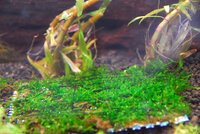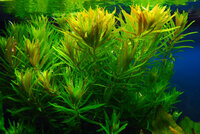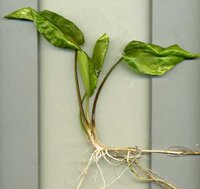As James mentioned, CO2 availability should always be considered within the context of light, as well as flow/distribution. There are many obstacles to gas exchange in a plant that gets suddenly flooded. So when we flood a tank with plants grown emmersed, the gas exchange now has to be supported and enhanced. It really isn't even so much that the quantity of CO2 is less. In a gas injected tank there is plenty of gas, but gasses cannot be transported in water as easily as they can be in air. Check the post
Cause of death? | UK Aquatic Plant Society for more information.
When you first submerge a plant they no longer have ready access to the important gases, CO2 and Oxygen. The places where air used to flow become flooded. Some gases are produced internal to the plant that have hormonal influences and those gases are not ejected as quickly as they once were, so the gas buildup changes the behavior and physiological response of the plant. Ethylene is such a gas. Certain concentration levels signal the plant to grow leggy, while other concentration levels programs the tissue cells to die.
So when you flood the tank and do not pay attention to the property of gasses in water the plants suffocate.
Injecting high CO2 pressures at the start allows a larger pressure differential of CO2 which helps to overcome some of the barriers to the movement of this gas into the tissue.
Cleaning the tank and preening the leaves removes organic waste buildup, which is a slime coating (bio-film) which covers the leaf and blocks movement of gases across this boundary.
Reducing the light intensity slows the growth and reduces the DEMAND for CO2.
Good flow and distribution encourages greater movement and dissipation of Ethylene away from the plant, so that awkward growth and senescence is reduced or eliminated. Gases that the plant needs also arrive and diffuse more quickly, reducing the stress and enabling better food production.
Regardless of where the plant originates, the combination of light, gas and water flow must be at satisfactory levels, otherwise the tissues are starved and they die.
Here, look at the stems in the background of this photo. You put nice plants in and they turn to mush.
I put mush in:
....and with careful management of flow/CO2 and nutrition they turn into this:
These are the same two stems that started life off in the tank on the brink of oblivion.
I don't have any of those issues that are so popular, plants rotting, leaves falling off, weird algal blooms. The plants just grow. I don't worry about KH, pH, GH, X, Y or Zh, which is the first mistake people make.
I just ensure that CO2/Flow/Distribution/Nutrients are beyond reproach, and I do not become obsessed with whether I have "enough light", which is the second biggest mistake that people make.
I do not fear nutrients, and I do not delete KNO3 dosing just because some water report or cheesy test kit tells me I have lots of Nitrate in the water, which is the third mistake people make.
I also do not put fish in the tank initially, which handcuffs you tremendously. That is the fourth biggest mistake people make Leave the fish out. Learn how to grow plants and master CO2 first. Then put fish in after you have figured out all the pitfalls.
Cheers,





